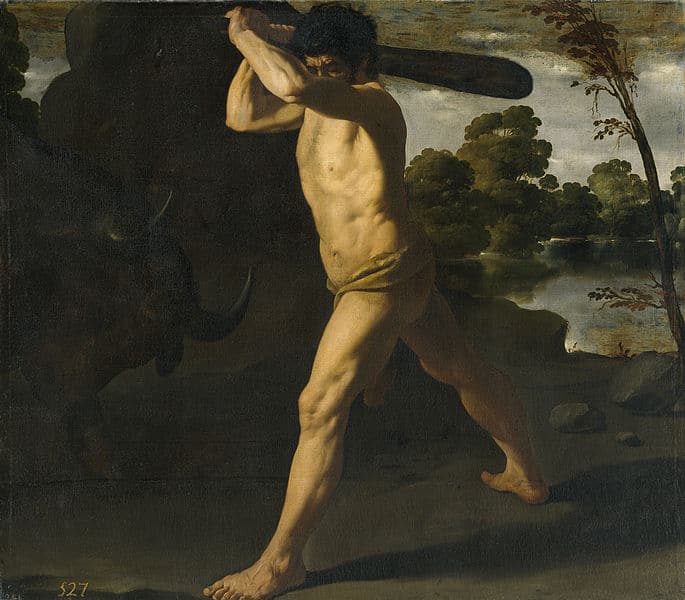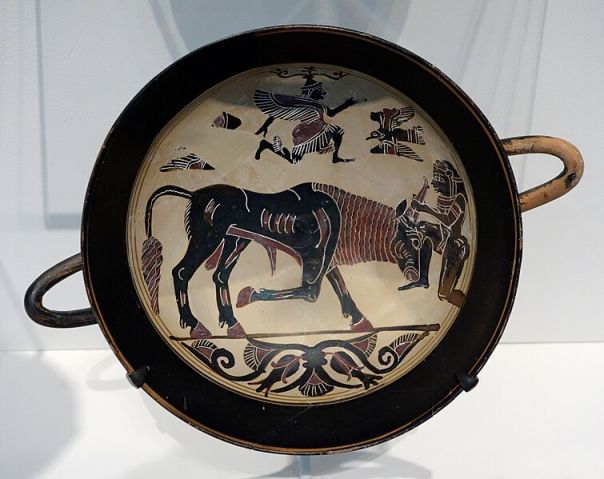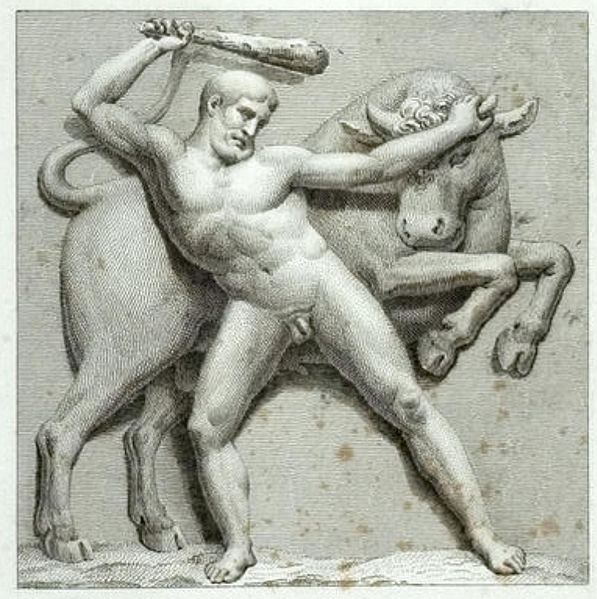The Cretan Bull was a creature of immense strength and significance in the annals of Greek mythology. This beast, with its tales of might and mischief, has intrigued scholars, artists, and enthusiasts for generations. As we embark on this journey, let’s unravel the mysteries surrounding this legendary creature and its place in the epic tales of Heracles.
Cretan Bull Key Facts
| Keyword | Facts |
|---|---|
| Origin | Crete |
| Creator | Poseidon |
| Defeated by | Heracles |
| Habitat | Island of Crete |
| Other names | Bull of Minos |
| Roman name | Taurean |
| Associated with | Minos, Pasiphaë, Minotaur |
| Symbols | Horns, strength, the Labyrinth |
Name and Etymology
The Cretan Bull, often referred to as the “Bull of Minos,” has its roots deeply embedded in the island of Crete. The name itself is derived from its place of origin. In Roman mythology, this creature is known as “Taurean.” Over time, various epithets and titles have been associated with this beast, each reflecting a different facet of its legend or the role it played in various myths.
The term “Cretan” is a direct reference to Crete, the island where this bull roamed and wreaked havoc. “Minos,” on the other hand, refers to the King of Crete, who had a significant role in the bull’s tale. The intertwining of the bull’s identity with the island and its king showcases the creature’s importance in the region’s mythology.

While the Greeks had their interpretation, the Romans, too, were captivated by this creature. In their tales, the Cretan Bull was often referred to as “Taurean,” a term derived from the Latin word for bull. This name, while different in sound, carried the same weight and significance as its Greek counterpart.
Cretan Bull Origin and Creation
The origins of the Cretan Bull are as intriguing as the tales that surround it. Legend has it that Poseidon, the god of the sea, sent the bull to King Minos of Crete. Minos had promised to sacrifice the bull to honor Poseidon; however, he reneged on his promise, captivated by the creature’s magnificent appearance.
This act of defiance did not sit well with Poseidon. In retaliation, he instilled a raging madness in the bull, causing it to terrorize the inhabitants of Crete. The bull’s creation and subsequent rampage were not just a display of its might but also a testament to the consequences of defying the gods.
The bull’s existence wasn’t just limited to tales of terror. It played a pivotal role in the birth of the Minotaur, a creature half-man and half-bull. Pasiphaë, the wife of King Minos, under a spell, fell in love with the Cretan Bull, leading to the birth of the Minotaur. This intertwining of the bull’s tale with that of the Minotaur further cements its significance in Greek mythology.
Cretan Bull Encounters and Conflicts
The tales of the Cretan Bull are rife with encounters and conflicts, each more intriguing than the last. As we delve deeper, we’ll explore some of the most iconic confrontations involving this mighty beast.
Heracles and the Cretan Bull

Heracles, known for his strength and valor, was tasked with capturing the Cretan Bull as his seventh labor. The bull, with its unmatched might and the madness instilled by Poseidon, was no easy foe. However, Heracles, with his unparalleled prowess, managed to subdue the beast, showcasing his indomitable spirit.
The capture of the Cretan Bull was not just a testament to Heracles’ strength but also his cunning. He realized that brute force alone wouldn’t suffice; he needed a strategy. By observing the bull’s movements and tendencies, Heracles found the perfect moment to strike, capturing the creature and completing his task.
The Bull and the Minotaur
The tale of the Minotaur is intrinsically linked to the Cretan Bull. As mentioned earlier, Pasiphaë’s unnatural love for the bull led to the birth of the Minotaur. This creature, trapped in the Labyrinth, became a symbol of terror for the people of Crete.
The Minotaur, with its human body and bull’s head, was a constant reminder of the consequences of defying the gods. Every year, young men and women were sent into the Labyrinth as a sacrifice to this beast. This tale, while centered around the Minotaur, constantly harkens back to the Cretan Bull, emphasizing its significance in the larger narrative.
Depiction And Characteristics

The Cretan Bull, in most depictions, is portrayed as a magnificent creature, radiating strength and power. Its muscular body, coupled with its large, curved horns, makes it a sight to behold. Often, artists chose to emphasize its size and might, showcasing it as a creature that could instill fear with just its presence.
Symbols often associated with the bull include its horns, representing strength and aggression, and the Labyrinth, a constant reminder of its connection to the Minotaur. These symbols, while simple, carry a weight of significance, tying the bull to various tales and legends.
Cretan Bull Nature and Behavior
The nature of the Cretan Bull is a blend of majesty and madness. On one hand, it’s a creature of immense strength and beauty, a testament to the craftsmanship of the gods. On the other, its madness, a result of King Minos’ defiance, showcases its capacity for destruction.
Ancient Greeks perceived the bull as a symbol of both reverence and caution. Its tales served as a reminder of the consequences of defying the gods and the importance of upholding promises. The bull’s behavior, a mix of calm and chaos, was a reflection of the duality of nature itself.
Cretan Bull Abilities
The Cretan Bull’s abilities are a subject of much fascination. Its strength, unmatched by any mortal creature, made it a formidable foe. Tales speak of its ability to wreak havoc, destroying entire villages and landscapes with its rampages.
However, its might wasn’t just physical. The madness instilled by Poseidon gave it an unpredictable edge, making it even more dangerous. This combination of physical prowess and unpredictability made the Cretan Bull a creature to be both revered and feared.
Cretan Bull Symbols or Associations
The Cretan Bull is often associated with various symbols, each carrying its own significance. Its horns, a symbol of strength and aggression, are a constant in most depictions. The Labyrinth, while more closely associated with the Minotaur, is also a reminder of the bull’s significance in the tale.
Another symbol often linked to the bull is the sea, a nod to Poseidon’s role in its creation. The tumultuous nature of the sea, with its calm and storms, mirrors the bull’s own duality. These associations, while varied, all tie back to the bull’s tales and significance in Greek mythology.
Myths about Cretan Bull
The Cretan Bull, with its tales of might and mischief, has been a central figure in various myths. As we delve deeper, we’ll explore some of the most iconic tales involving this legendary creature.
The Birth of the Minotaur
The tale of the Minotaur’s birth is one of love, deceit, and consequences. Pasiphaë, under a spell, fell deeply in love with the Cretan Bull. This unnatural love led to the birth of the Minotaur, a creature half-man and half-bull. Trapped in the Labyrinth, the Minotaur became a symbol of terror for the people of Crete.
This tale serves as a cautionary story about the consequences of defying the gods. The Minotaur, with its human body and bull’s head, was a constant reminder of Pasiphaë’s transgressions and the price the people of Crete had to pay for it.
Heracles’ Seventh Labor
The legend of Heracles and the Cretan Bull stands as a monumental chapter in the vast tapestry of Greek mythology. This story is not merely an account of a hero’s confrontation with a beast; it is a vivid portrayal of the interplay between raw power and strategic acumen. Heracles, often celebrated for his unparalleled strength, was given the daunting task of capturing the Cretan Bull, a creature of immense power and fury that had been wreaking havoc across the island of Crete. The challenge was not just to overpower the bull, but to do so without causing it harm.
While the narrative revolves around Heracles’ quest, the Cretan Bull is not a mere backdrop. Its presence is felt throughout, serving as both an adversary and a symbol. The bull’s significance in the story is multifaceted. On one hand, it represents the wild, untamed forces of nature that even the mightiest of heroes must reckon with. On the other, it underscores the recurring theme in Greek myths where creatures, often misunderstood or maligned, play pivotal roles in the destinies of heroes.
The Mastery of Heracles: Beyond Brute Strength

Heracles’ encounter with the Cretan Bull is not just a display of his physical might; it’s a masterclass in observation, patience, and timing. Rather than rushing headlong into battle, Heracles studied the bull. He noted its patterns, its moments of aggression, and its periods of calm. This meticulous observation allowed him to discern the opportune moment to act. When he finally made his move, it was with a combination of strength and strategy, ensuring the bull’s capture without causing it undue harm. This approach not only highlighted Heracles’ respect for the creature but also showcased a side of the hero that went beyond mere muscle. It was this blend of brawn and brains that truly cemented Heracles’ legendary status, proving that true heroism is as much about wisdom as it is about strength.
Representations Of Cretan Bull In Art
The Cretan Bull, with its tales of might and terror, has inspired artists for generations. From intricate sculptures to detailed paintings, the bull has been depicted in various forms, each capturing a different facet of its legend.
One of the most iconic representations is the sculpture of Heracles capturing the Cretan Bull. This piece, with its intricate detailing, captures the tension and drama of the moment, showcasing both Heracles’ strength and the bull’s might. Another popular depiction is the painting of Pasiphaë and the bull, a reminder of the tale that led to the birth of the Minotaur.
These artworks, while varied in form and style, all capture the essence of the Cretan Bull, showcasing its significance in Greek mythology.
Mentions in Ancient Texts
The Cretan Bull’s tales have been documented in various ancient texts, each offering a unique perspective on the creature. From detailed accounts of its encounters to mentions of its significance, these texts provide a glimpse into the bull’s place in Greek mythology.
One of the most notable mentions is in the works of Apollodorus, who provides a detailed account of Heracles’ encounter with the bull. He writes, “Heracles set out for Crete, and when, upon his arrival, he was purified by Minos and had received the bull, he conveyed it to the Peloponnesus.”
Another text, the “Iliad” by Homer, alludes to the bull’s significance, tying it to the larger narrative of the Trojan War. These mentions, while varied, all emphasize the bull’s importance in the annals of Greek mythology.
Frequently Asked Questions
Poseidon sent the Cretan Bull to King Minos of Crete. When Minos failed to sacrifice the bull, Poseidon instilled madness in the creature, leading to its rampages.
Pasiphaë, under a spell, fell in love with the Cretan Bull, leading to the birth of the Minotaur, a creature half-man and half-bull.
Heracles was tasked with capturing the Cretan Bull as his seventh labor. Using his strength and cunning, he managed to subdue the beast.
Yes, when King Minos failed to sacrifice the bull, Poseidon instilled madness in the creature, leading to its rampages across Crete.
Featured Image Credit: Paolo Villa, Public domain, via Wikimedia Commons
